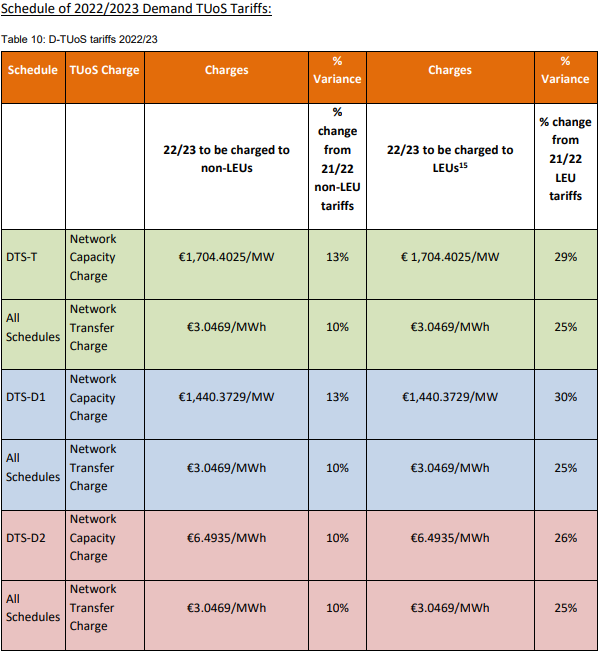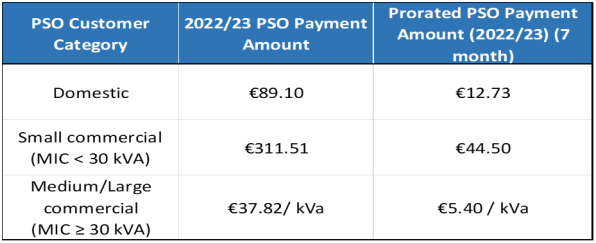The unit price (i.e. the kilowatt hour (kWh) rate) Pinergy charge you in your electricity supply contract includes both the Pinergy energy charge and regulated pass-through charges.
As highlighted in your contract, the Pinergy energy charge will follow the agreed fixed energy price per unit, for the duration of the contract. Pass-through costs will only change with approval by the Regulator, the Commission for Regulation of Utilities (“CRU”).
The various pass-through charges charged by ESB Networks, Eirgrid and the Single Energy Market Operator (SEMO) for the 2022 – 2023 period have now been approved by the CRU.
What are Pass-through charges?
The level of pass-through charges applicable to you are dependent on your DUoS group or DG number as assigned by ESB Networks. Pass through charges are charges that all electricity suppliers must pay other entities in the Integrated Single Electricity Market (iSEM) when supplying electricity to customers, such as those incurred for the use of the ESB Networks and Eirgrid’s systems.
Usually, SEMO, ESB Networks and Eirgrid set these charges, subject to regulatory approval (i.e. the CRU), on an annual basis.
Pass-through charges include:
Transmission Use Of Systems (TUOS);
- TUoS charges are the costs all electricity suppliers pay to Eirgrid to transport electricity from the generation station through the transmission grid to the distribution system (or to the customers site for the small number of customers connected to the transmission system). The transmission system is the high voltage system for the movement of most of the electricity. The Transmission Use of System (TUoS) charge is set by Eirgrid and regulated by the CRU. The 2022/2023 charges are set out below including percentage change versus 2021/22:

Distribution Use Of Systems (DUOS);
- DUoS tariffs are charged to suppliers based on the amount of energy used by their customers, and include standing charges. The DSO charges are calculated annually based on the ‘allowed revenue’ (as determined by the CRU). Every year, a published an Information Paper on the allowed revenue for ESB Networks as DSO, and DUoS tariffs and DLAFs for the coming tariff year. Links to the 2022/2023 and 2021/2022 information papers are below:
Market Operator Charges;
- These are charges applied to generators and suppliers for the operation of wholesale markets.
Supplier Capacity Charge Price
- The administratively determined CPM in SEM is being replaced with a competitively determined Capacity Remuneration Mechanism (CRM) with the price for awarded capacity determined through an auction process. Capacity Payments will be funded through a Capacity Charge tariff which is socialised across all suppliers on a monthly basis based upon their daytime demand profile. The 2022/23 Supplier Capacity Charge is €11.97 per mwh based on their daytime demand profile versus €14.01 in 2021/22.
Difference Payment Socialisation Multiplier
- The capacity difference payment socialisation fund is a new mechanism in I-SEM. The revenue to fund awarded capacity is recovered from suppliers through a capacity charge. In return, the suppliers are hedged against high energy prices. The purpose of this tariff is to ensure suppliers are fully hedged against high price events. This is separate to the Supplier Capacity Charge itself. If inadequate funds have been built up to fully cover difference payments that need to be made, the Market Operator may use the over recovery of other charges to fund these. Otherwise, the Market Operator has the right to “suspend and accrue” until funds build up again. The 2022/23 capacity difference payment socialization is € NIL per mwh versus €NIL in 2021/22
Residual Error Volume Price
- The Residual Error Volume Loss Factor (REVLF) relates to differences between actual and metered volumes that can swing in both positive and negative directions. The key difference in the REVLF between SEM and I-SEM is that costs are recovered in a tariff arrangement, rather than from close to real-time recovery as is carried out in SEM. The 2020/21 REVLF is a refund of €0.67 per mwh versus a charge of €0.70 in 2021/22
Currency cost price and currency adjustment charge factor
- Due to the existence of two currencies within the SEM/I-SEM, variation between these can occur in incoming and outgoing amounts in the market. The variation is covered through the Currency Adjustment Charge. The 2022/23 currency adjustment charge is €0.029 per mwh versus € NIL in 2021/22
Imperfection Charges;
- SEMO also recovers costs on an annual basis in relation to imperfection charges. Imperfections are made up of Make Whole Payments, Energy Imbalance Charges and Dispatch Balancing Costs (constraint costs). These are all costs relating to the operation of the grid. The 2019/20 Imperfection charge is €21.85 per mwh versus €9.19 in 2021/22.
Variable Market Operator Price;
- The Variable Market Operator Price is a mechanism designed to cover the costs incurred by SEMO in balancing the electricity supply and demand in real time. It reflects the cost of managing and maintaining the balance between electricity generation and consumption on the island of Ireland. The 2022/23 Variable Market Operator Price charge is €0.422 per mwh versus €0.547 in 2021/22.
PSO levy;
- The Public Service Obligation Levy (PSO) is charged on all electricity customers and designed to support the national policy objectives of security of supply, the use of indigenous fuels (i.e. peat) and the use of renewable energy sources in electricity generation. The CRU updates the PSO charge annually. The updated rates apply from the 1st of October until the 30th of September every year. The CRU made a decision to issue a credit for the 2022/23 period. The credit will be issued on a pro rata basis from March 2023. Associated credits are set out below:
